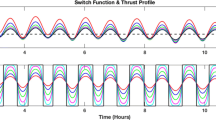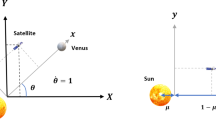Abstract
A cell-mapping approach is implemented and parallelized to analyze three-body problem orbits in the vicinity of icy moons (Europa and Enceladus). The cell-mapping method is developed for studying nonlinear dynamics with periodic motions. The method does not require previously known solutions as inputs, which is an essential requirement of continuation approaches, and does not impose symmetric constraints. As major strengths of the method, multiple-period periodic solutions and bifurcation studies can be easily performed. This method is especially applicable to a systematic periodic orbit search over a region of interest using an integration time of one period. The parallelized cell-mapping method facilitates a rapid understanding of the global dynamics.

















Similar content being viewed by others
References
Poincaré, H.: New methods of celestial mechanics (english translation history of modern physics and astronomy, american institute of physics, Vol. 13 (1993)
Szebehely, V.: Theory of Orbits-The restricted problem of three bodies, pp 443–449. Academic press, New York and London (1967)
Goudas, C.L.: Three-Dimensional Periodic Orbits and Their Stability. Icarus 2, 1–18 (1963)
Message, P.J.: On asymmetric periodic solutions of the plane restricted problem of three bodies. In: Giacaglia, G.E.O. (ed.) Periodic Orbits Stability and Resonances, pp. 19–32 (1970)
Farquhar, R.W., Kamel, A.A.: Quasi-periodic orbits about the translunar libration point. Celestial Mechanics 7, 458–473 (1973)
Markellos, V.V., Black, W., Moran, P.E.: A grid search for families of periodic orbits in the restricted problem of three bodies celes. Mech. 9, 507–512 (1974)
Kazantzis, P.G., Goudas, C.L.: A grid search for three-dimensional motions and three new types of such motions. Astrophysics and Space Science 32, 95–113 (1975)
Markellos, V.V.: Asymmetric periodic orbits in three dimensions. Mon. Not. R. astr Soc. 184, 273–281 (1978)
Breakwell, J.V., Brown, J.V.: The Halo family of 3-dimensional periodic orbits in the Earth-Moon restricted 3-body problem. Celestial Mechanics 20, 389–404 (1979)
Robin, I.A., Markellos, V.V.: Numerical Determination of Three-Dimensional Periodic Orbits Generated from Vertical Self-Resonant Satellite Orbits. Celestial Mechanics 21, 395–434 (1980)
Howell, K.C.: Three-dimensional, periodic, ‘Halo’ Orbits. Celestial Mechanics 32(1), 53–71 (1984)
Zagouras, C.G.: Three-dimensional periodic orbits about the triangular equilibrium points of the restricted problem of three bodies. Celestial Mechanics 37, 27–46 (1985)
Henon, M.: New families of periodic orbits in Hill’s problem of three bodies celest. Mech. Dyn. Astr. 85(3), 223–236 (2003)
Papadakis, K.E.: Families of Asymmetric Periodic Orbits in the Restricted Three-Body Problem. Earth Moon Planet 103, 25–42 (2008)
Roy, A.E., Ovenden, M.W.: On the occurrence of commensurable mean motions in the solar system: the mirror theorem. Monthly Notices of the Royal Astronomical Society 115(3), 296–309 (1955)
Farquhar, R.W.: The utilization of halo orbits in advanced lunar operations NASA technical report TN d-6365 (1971)
Marchand, B.G., Howell, K.C., Wilson, R.: Improved corrections process for constrained trajectory design in the n-body problem. Journal of Spacecraft and Rockets 44(4), 884–497 (2007)
Taylor, D.B.: Families of asymmetric periodic solutions of the restricted problem of three bodies for the Sun-Jupiter mass ratio and their relationship with the symmetric families. Celestial Mechanics 29, 51–74 (1983)
Hénon, M.: Vertical stability of periodic orbits in the restricted problem astron. Astrophys. 28, 415–426 (1973)
Zagouras, C., Markellos, V.V.: Axisymmetric Periodic Orbits of the Restricted Problem in Three Dimensions. Astro. & Astrophys. 59, 79–89 (1977)
Tsirogiannis, G.A., Perdios, E.A., Markellos, V.V.: Improved grid search method: an efficient tool for global computation of periodic orbits. Celest. Mech. Dyn. Astr. 103, 49–78 (2009)
Russell, R.P.: Global search for planar and Three-Dimensional periodic orbits near Europa. The Journal of the Astronautical Sciences 54(2), 199–226 (2006)
Dunham, D.W., Farquhar, R.W.: Libration point mission, 1978–2002 Libration Point Orbits and applications: Proceedings of the Conference, Aiguablava, Spain, 10-14, June 45–73 (2002)
Hsu, C.S.: A Theory of Cell-to-Cell Mapping Dynamical Systems. J. Applied Mechanics 47(4), 931–939 (1980)
Hsu, C.S.: An Unraveling Algorithm for Global Analysis of Dynamical systems: An Application of Cell-to-Cell Mappings. J. Applied Mechanics 47(4), 940–948 (1980)
Dellnitz, M., Junge, O.: On the approximation of complicated dynamical behavior. SIAM Journal on Numerical Analysis 36(2), 491–515 (1999)
Dellnitz, M., Froyland, G., Junge, O.: The algorithms behind GAIO – Set oriented numerical methods for dynamical systems Ergodic Theory, Analysis, and Efficient Simulation of Dynamical Systems, pp 145–174. Springer Fiedler, B., Berlin (2001)
Dellnitz, M., Junge, O.: Set Oriented Numerical Methods in Space Mission Design Modern Astrodynamics, Elsevier Astrodynamics Series. Butterworth-Heinemann, Oxford (2006)
Wang, F., Lever, P.: A cell mapping method for general optimum trajectory planning of multiple robotic arms. Robotics and Autonomous Systems 12, 15–27 (1994)
Koh, D., Flashner, H.: Global analysis of gravity gradient satellite’s pitch motion in an elliptic orbit. Journal of Computational and Nonlinear Dynamics 10(6), 061020 (2015)
Koh, D., Anderson, R.L.: Periodic orbit-attitude solutions in the planar elliptic restricted three-body problem AIAA/AAS Astrodynamics specialist conference, Long Beach, CA, September, 13–16 ASD-36 2490399 (2016)
Ding, Q., Cooper, J.E., Leung, A.Y.T.: Application of an improved cell mapping method to bilinear stiffness aeroelastic systems. Journal of Fluids and Structures 20, 35–49 (2005)
Lunine, I.J.: Ocean Worlds Exploration. Acta Astronautica 131, 123–130 (2017)
Koh, D.: Periodic Motion Analysis in Spacecraft Attitude Dynamics Ph.D. Thesis, University Southern, California, May (2016)
Flashner, H., Hsu, C.S.: A study of nonlinear periodic systems via the point mapping method international. Journal for Numerical Methods in Engineering 19(2), 185–215 (1983)
Guttalu, R.S., Flashner, H.: Stability Analysis of Periodic Systems by Truncated Point Mapping. Journal of Sound and Vibration 189(1), 33–54 (1996)
Parker, J.S., Anderson, R.L.: Low-energy lunar trajectory design. John Wiley & Sons, Hoboken (2014)
Broucke, R.A.: Periodic orbits in the restricted Three-Body problem with Earth-Moon masses jet propulsion laboratory, technical report 32-1168, February 15 (1968)
Lam, T., Whiffen, G.J.: Exploration of Distant Retrograde Orbits around Europa AAS/AIAA Space Flight Mechanics Meeting Copper Mountain, Colorado (2005)
Lara, M., Russell, R., Villac, B.: Classification of the distant stability regions at Europa. Journal of Guidance, Control, and Dynamics 30(2), 409–418 (2007)
Russell, R., Lara, M.: On the Design of an Enceladus Science Orbit. Acta Astronautica 65(1-2), 27–39 (2009)
Davis, D.C., Phillips, S.M., McCarthy, B.P.: Trajectory design for Saturnian Ocean Worlds orbiters using multidimensional Poincarè maps. Acta Astronautica 143, 16–28 (2018)
Koh, D., Anderson, R.L., Bermejo-Moreno, I.: Three-dimensional bifurcations in the circular bifurcations in the circular restricted three-body problem AAS/AIAA Astrodynamics specialist conference, Snowbird, UT, August, 19–23 AAS, pp. 18–264 (2018)
Acknowledgments
The research was carried out at the Jet Propulsion Laboratory, California Institute of Technology, under a contract with the National Aeronautics and Space Administration. NASA Postdoctoral Program fellowship acknowledged. The High Performance Computing resources used in this investigation were provided by funding from the JPL Office of the Chief Information Officer.
Author information
Authors and Affiliations
Corresponding author
Ethics declarations
Conflict of Interests
On behalf of all authors, the corresponding author states that there is no conflict of interest.
Additional information
Publisher’s Note
Springer Nature remains neutral with regard to jurisdictional claims in published maps and institutional affiliations.
Appendix: :Parallelization of Unraveling Algorithm
Appendix: :Parallelization of Unraveling Algorithm
In the parallel algorithm all processes run a synchronized sequence of steps. An integer variable ‘step’ keeps track of the step number during the execution. The following local arrays, of length equal to the local number of cells in each process, are defined: ‘target’, ‘next-target’, ‘sum’, and ‘final’. When a cell z is identified as periodic during the unraveling algorithm execution, the corresponding ‘step’ values will be set to positive integers corresponding to the Step Number (S) defined earlier. At each ‘step’, the values ‘target’, ‘next-target’ and ‘sum’ are updated from the cell-map, C, as ‘target(z)=Cstep(z)’, ‘next-target(z)=C(target(z))’ and ‘sum(z)=sum(z)+target(z)’, for each cell ‘z’ that has not been assigned to a group number yet. A vector ‘PO’ keeps track of the periodic solutions found in the successive iterations, adding any newly found periodic solutions in each step to the existing ones. Components of ‘final’ are finally updated to track where a cell z is mapped eventually, and this eventually sorts the different Groups defined earlier.
At initialization, all elements of the ‘final’ and ‘sum’ arrays are set to − 1 and 0, respectively, and the ‘PO’ vector is empty. The iterative process stops when all cells have been assigned to a group, that is, when all values in the ‘final’ array are different from − 1, for all processes. The parallelized unraveling algorithm can be split into four stages. Figures 3 – 6 provide a visual representation of these four stages, where each circle 1 to N represents a process (MPI rank) running in parallel and the two-way arrows represent communications between processes:
-
1.
Figure 18 summarizes the first step of the parallelized unraveling algorithm. For each cell ‘z’ such that ‘final(z)’ is − 1, obtain ‘target(z)=Cstep(z)’. If the cell given by ‘target(z)’ resides in this process (i.e., the MPI rank of cell ‘target(z)’ is the same as the MPI rank of cell ‘z’), then ‘next-target(z)’ can be obtained as ‘C(target)’ locally (i.e., without communication). Otherwise, if the cell given by ‘target(z)’ is local to another process (i.e., the MPI rank of the cell ‘target(z)’ is different from the MPI rank of the cell ‘z’), then inter-process communication is required to retrieve ‘next-target(z)’, which is temporarily set to − 1. The inter-process communication pattern is set by grouping data requests per process, to minimize the number of communication exchanges, by means of the arrays ‘comm’ and ‘pckg’.
-
2.
Inter-process data communication to ‘C(target(z))’ and update ‘next-target(z)’ for those cells with non-local ‘target(z)’. This step uses the ‘comm’ and ‘pckg’ arrays to formulate the send and receive MPI call pairs between processes at once. A broadcast call from each process is needed first to warn all the other processes that should expect to receive data requests. A schematic diagram for this step is presented in Fig. 19.
-
3.
Identify periodic cells and update the corresponding ‘final(z)’ by comparing ‘next-target(z)’ to ‘z’ and existing periodic cell groups. Newly found periodic solutions are added in this step to the collection of existing ones in the vector called ‘PO.’ A flow chart for this is shown in Fig. 20.
-
4.
Check for the stop condition: for each process if ‘final(z)’ is equal to − 1 for any z set ‘locally_not_done’ to 1, and to 0 otherwise. Sum ‘locally_not_done’ among all processes via a call to ‘MPI_Allreduce’ into ‘globally_not_done’. If ‘globally_not_done’ is 0 then stop, otherwise continue proceeding to stage 1 again. A schematic diagram for this step is presented in Fig. 21.
Rights and permissions
About this article
Cite this article
Koh, D., Anderson, R.L. & Bermejo-Moreno, I. Cell-mapping orbit search for mission design at ocean worlds using parallel computing. J Astronaut Sci 68, 172–196 (2021). https://doi.org/10.1007/s40295-021-00251-6
Accepted:
Published:
Issue Date:
DOI: https://doi.org/10.1007/s40295-021-00251-6








